PROJ 6002: Project Planning and Budgeting - Cost & Quality Plans
VerifiedAdded on 2022/11/28
|9
|2131
|243
Report
AI Summary
This report addresses project planning and budgeting, focusing on cost and quality management. Part A includes a module discussion on project quality, emphasizing the importance of quality management in achieving project success, discussing tools like cause-and-effect diagrams and the relationship between cost and quality. Part B details cost and quality management plans. The cost management plan covers processes like cost-benefit analysis, NPV, payback period, and scoring models, along with tools such as expert judgment and parametric estimation, justifying the use of bottom-up and analogous estimation. The quality management plan outlines processes including quality assurance, quality control, and quality improvement, and explores tools like cause-and-effect diagrams, Pareto charts, and control charts, justifying the use of quality management plans for project success. The report concludes with a bibliography of relevant sources.
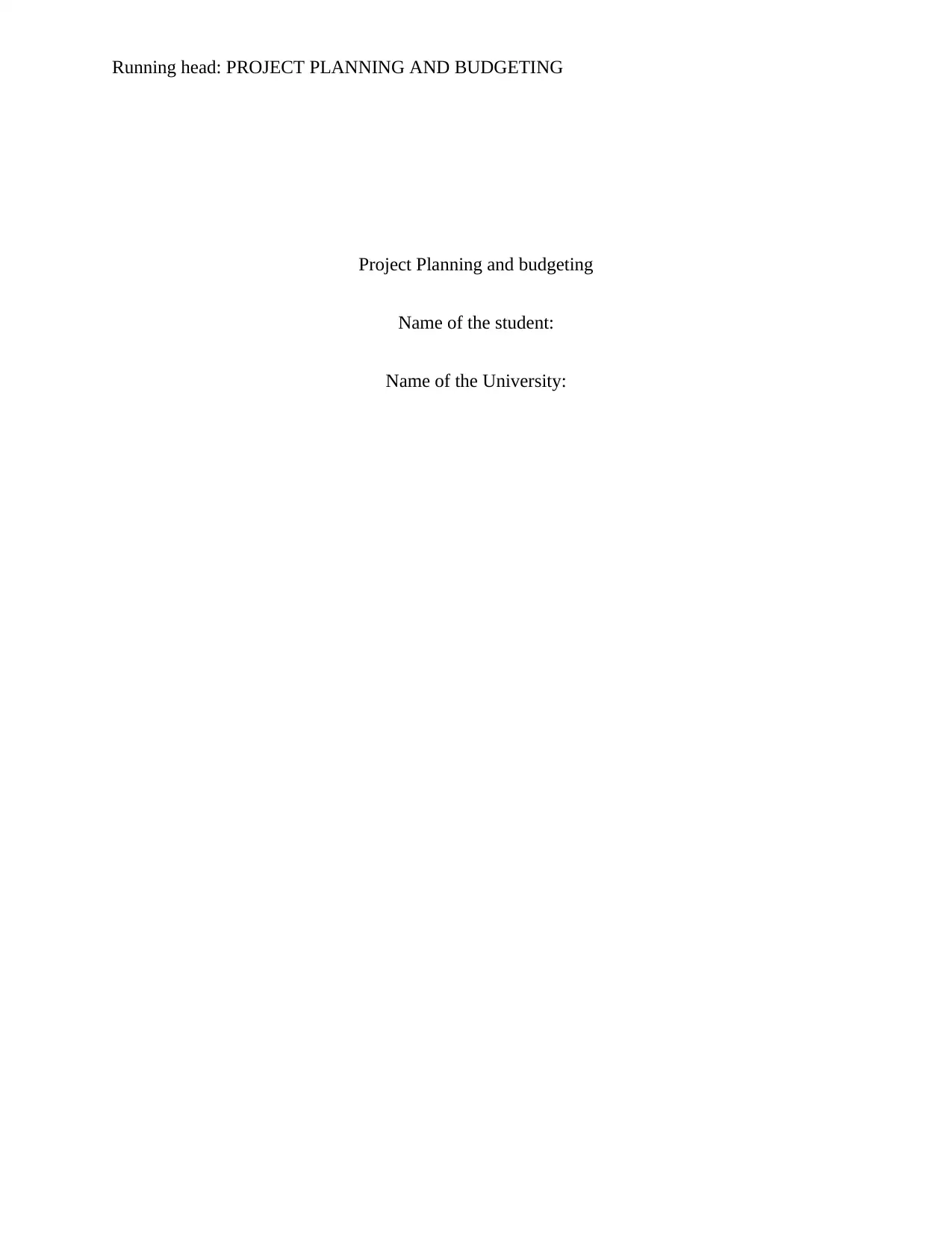
Running head: PROJECT PLANNING AND BUDGETING
Project Planning and budgeting
Name of the student:
Name of the University:
Project Planning and budgeting
Name of the student:
Name of the University:
Paraphrase This Document
Need a fresh take? Get an instant paraphrase of this document with our AI Paraphraser
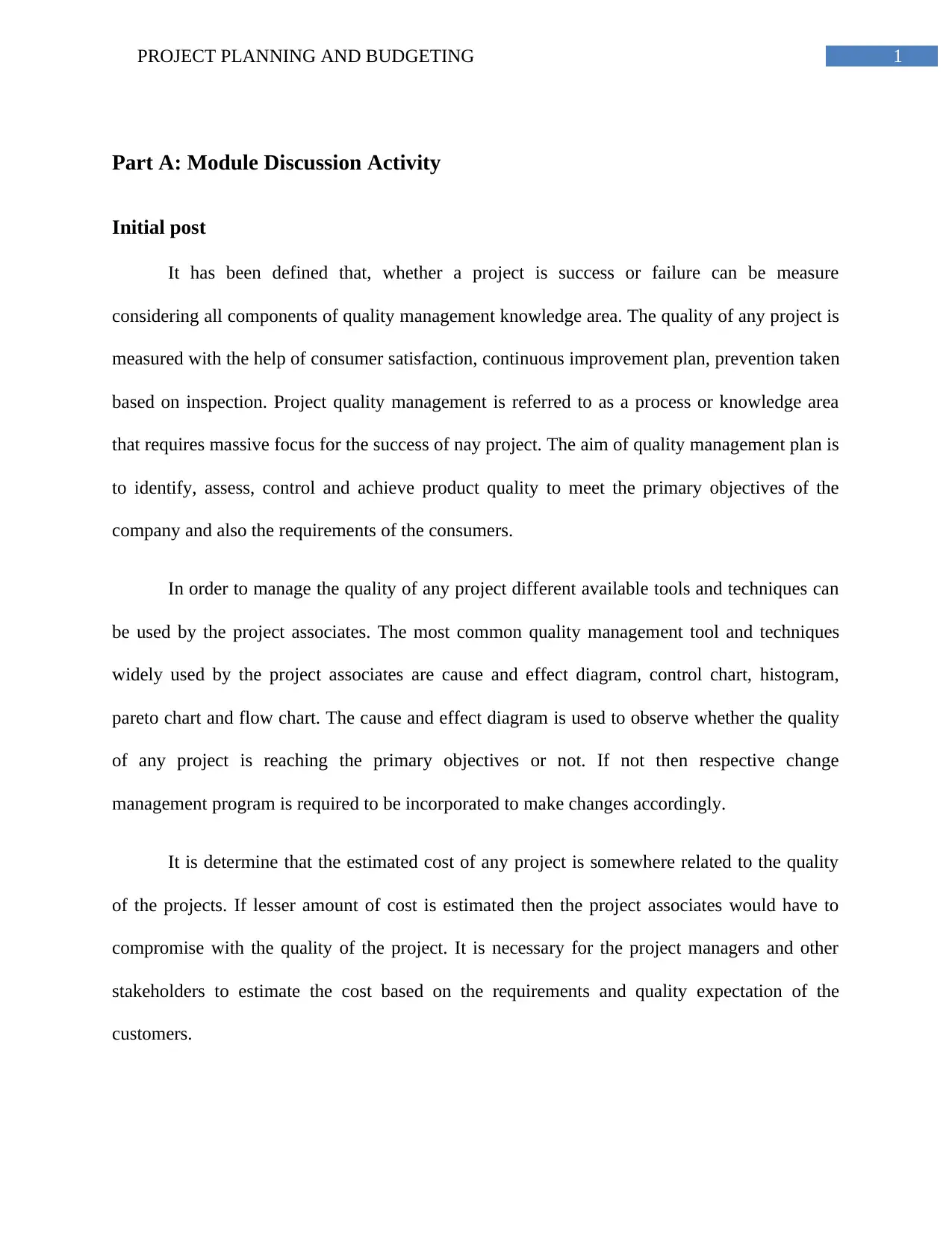
1PROJECT PLANNING AND BUDGETING
Part A: Module Discussion Activity
Initial post
It has been defined that, whether a project is success or failure can be measure
considering all components of quality management knowledge area. The quality of any project is
measured with the help of consumer satisfaction, continuous improvement plan, prevention taken
based on inspection. Project quality management is referred to as a process or knowledge area
that requires massive focus for the success of nay project. The aim of quality management plan is
to identify, assess, control and achieve product quality to meet the primary objectives of the
company and also the requirements of the consumers.
In order to manage the quality of any project different available tools and techniques can
be used by the project associates. The most common quality management tool and techniques
widely used by the project associates are cause and effect diagram, control chart, histogram,
pareto chart and flow chart. The cause and effect diagram is used to observe whether the quality
of any project is reaching the primary objectives or not. If not then respective change
management program is required to be incorporated to make changes accordingly.
It is determine that the estimated cost of any project is somewhere related to the quality
of the projects. If lesser amount of cost is estimated then the project associates would have to
compromise with the quality of the project. It is necessary for the project managers and other
stakeholders to estimate the cost based on the requirements and quality expectation of the
customers.
Part A: Module Discussion Activity
Initial post
It has been defined that, whether a project is success or failure can be measure
considering all components of quality management knowledge area. The quality of any project is
measured with the help of consumer satisfaction, continuous improvement plan, prevention taken
based on inspection. Project quality management is referred to as a process or knowledge area
that requires massive focus for the success of nay project. The aim of quality management plan is
to identify, assess, control and achieve product quality to meet the primary objectives of the
company and also the requirements of the consumers.
In order to manage the quality of any project different available tools and techniques can
be used by the project associates. The most common quality management tool and techniques
widely used by the project associates are cause and effect diagram, control chart, histogram,
pareto chart and flow chart. The cause and effect diagram is used to observe whether the quality
of any project is reaching the primary objectives or not. If not then respective change
management program is required to be incorporated to make changes accordingly.
It is determine that the estimated cost of any project is somewhere related to the quality
of the projects. If lesser amount of cost is estimated then the project associates would have to
compromise with the quality of the project. It is necessary for the project managers and other
stakeholders to estimate the cost based on the requirements and quality expectation of the
customers.
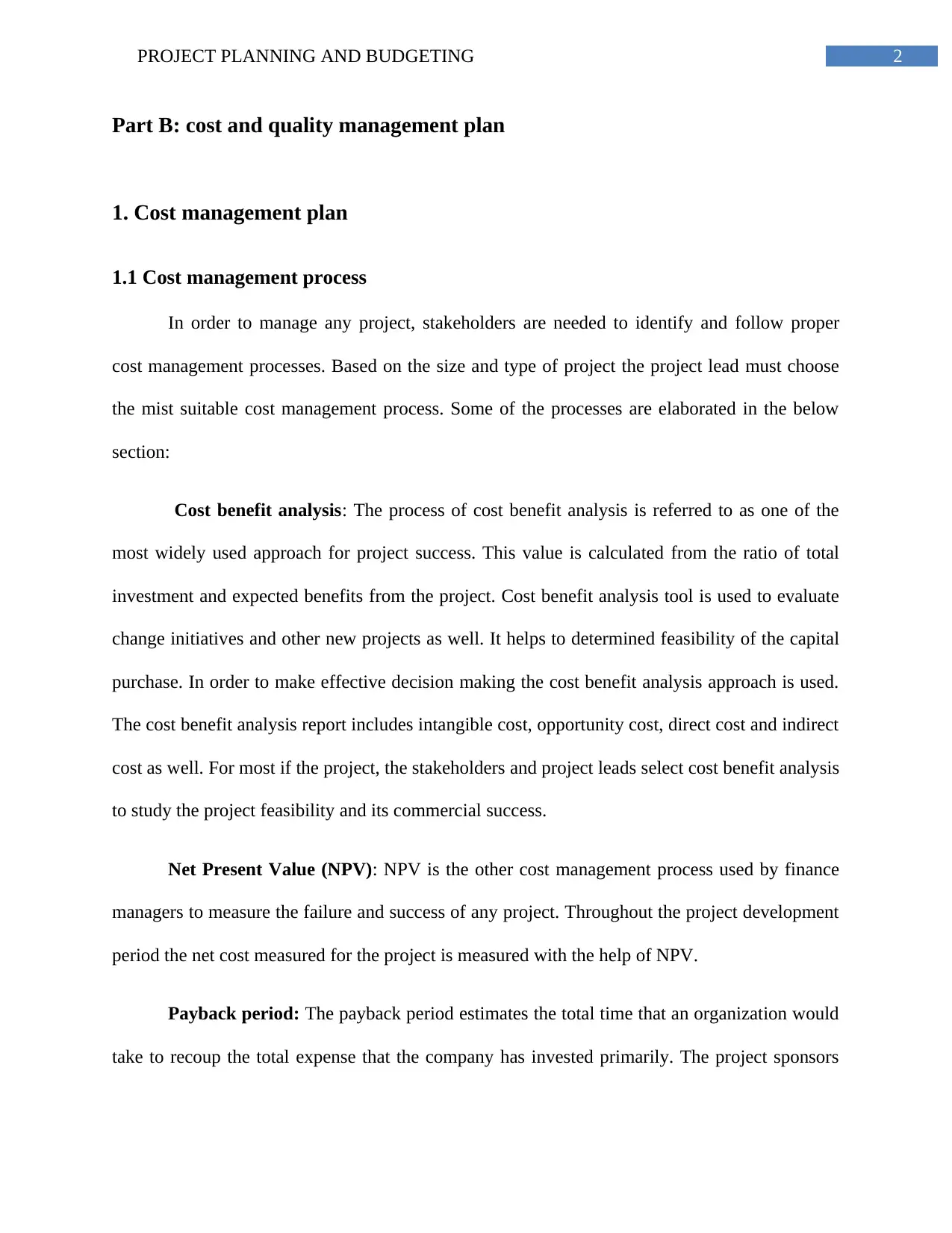
2PROJECT PLANNING AND BUDGETING
Part B: cost and quality management plan
1. Cost management plan
1.1 Cost management process
In order to manage any project, stakeholders are needed to identify and follow proper
cost management processes. Based on the size and type of project the project lead must choose
the mist suitable cost management process. Some of the processes are elaborated in the below
section:
Cost benefit analysis: The process of cost benefit analysis is referred to as one of the
most widely used approach for project success. This value is calculated from the ratio of total
investment and expected benefits from the project. Cost benefit analysis tool is used to evaluate
change initiatives and other new projects as well. It helps to determined feasibility of the capital
purchase. In order to make effective decision making the cost benefit analysis approach is used.
The cost benefit analysis report includes intangible cost, opportunity cost, direct cost and indirect
cost as well. For most if the project, the stakeholders and project leads select cost benefit analysis
to study the project feasibility and its commercial success.
Net Present Value (NPV): NPV is the other cost management process used by finance
managers to measure the failure and success of any project. Throughout the project development
period the net cost measured for the project is measured with the help of NPV.
Payback period: The payback period estimates the total time that an organization would
take to recoup the total expense that the company has invested primarily. The project sponsors
Part B: cost and quality management plan
1. Cost management plan
1.1 Cost management process
In order to manage any project, stakeholders are needed to identify and follow proper
cost management processes. Based on the size and type of project the project lead must choose
the mist suitable cost management process. Some of the processes are elaborated in the below
section:
Cost benefit analysis: The process of cost benefit analysis is referred to as one of the
most widely used approach for project success. This value is calculated from the ratio of total
investment and expected benefits from the project. Cost benefit analysis tool is used to evaluate
change initiatives and other new projects as well. It helps to determined feasibility of the capital
purchase. In order to make effective decision making the cost benefit analysis approach is used.
The cost benefit analysis report includes intangible cost, opportunity cost, direct cost and indirect
cost as well. For most if the project, the stakeholders and project leads select cost benefit analysis
to study the project feasibility and its commercial success.
Net Present Value (NPV): NPV is the other cost management process used by finance
managers to measure the failure and success of any project. Throughout the project development
period the net cost measured for the project is measured with the help of NPV.
Payback period: The payback period estimates the total time that an organization would
take to recoup the total expense that the company has invested primarily. The project sponsors
⊘ This is a preview!⊘
Do you want full access?
Subscribe today to unlock all pages.

Trusted by 1+ million students worldwide
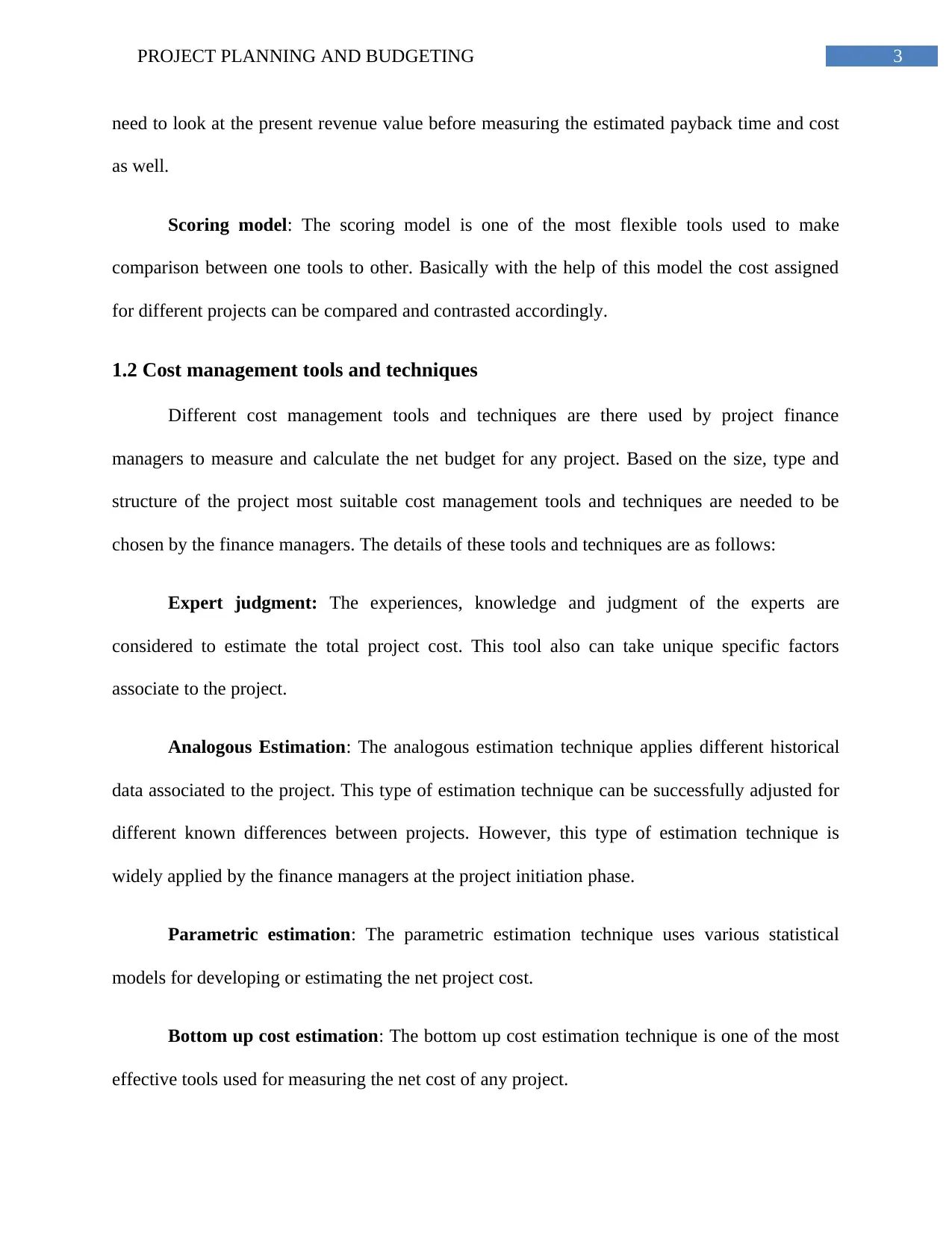
3PROJECT PLANNING AND BUDGETING
need to look at the present revenue value before measuring the estimated payback time and cost
as well.
Scoring model: The scoring model is one of the most flexible tools used to make
comparison between one tools to other. Basically with the help of this model the cost assigned
for different projects can be compared and contrasted accordingly.
1.2 Cost management tools and techniques
Different cost management tools and techniques are there used by project finance
managers to measure and calculate the net budget for any project. Based on the size, type and
structure of the project most suitable cost management tools and techniques are needed to be
chosen by the finance managers. The details of these tools and techniques are as follows:
Expert judgment: The experiences, knowledge and judgment of the experts are
considered to estimate the total project cost. This tool also can take unique specific factors
associate to the project.
Analogous Estimation: The analogous estimation technique applies different historical
data associated to the project. This type of estimation technique can be successfully adjusted for
different known differences between projects. However, this type of estimation technique is
widely applied by the finance managers at the project initiation phase.
Parametric estimation: The parametric estimation technique uses various statistical
models for developing or estimating the net project cost.
Bottom up cost estimation: The bottom up cost estimation technique is one of the most
effective tools used for measuring the net cost of any project.
need to look at the present revenue value before measuring the estimated payback time and cost
as well.
Scoring model: The scoring model is one of the most flexible tools used to make
comparison between one tools to other. Basically with the help of this model the cost assigned
for different projects can be compared and contrasted accordingly.
1.2 Cost management tools and techniques
Different cost management tools and techniques are there used by project finance
managers to measure and calculate the net budget for any project. Based on the size, type and
structure of the project most suitable cost management tools and techniques are needed to be
chosen by the finance managers. The details of these tools and techniques are as follows:
Expert judgment: The experiences, knowledge and judgment of the experts are
considered to estimate the total project cost. This tool also can take unique specific factors
associate to the project.
Analogous Estimation: The analogous estimation technique applies different historical
data associated to the project. This type of estimation technique can be successfully adjusted for
different known differences between projects. However, this type of estimation technique is
widely applied by the finance managers at the project initiation phase.
Parametric estimation: The parametric estimation technique uses various statistical
models for developing or estimating the net project cost.
Bottom up cost estimation: The bottom up cost estimation technique is one of the most
effective tools used for measuring the net cost of any project.
Paraphrase This Document
Need a fresh take? Get an instant paraphrase of this document with our AI Paraphraser
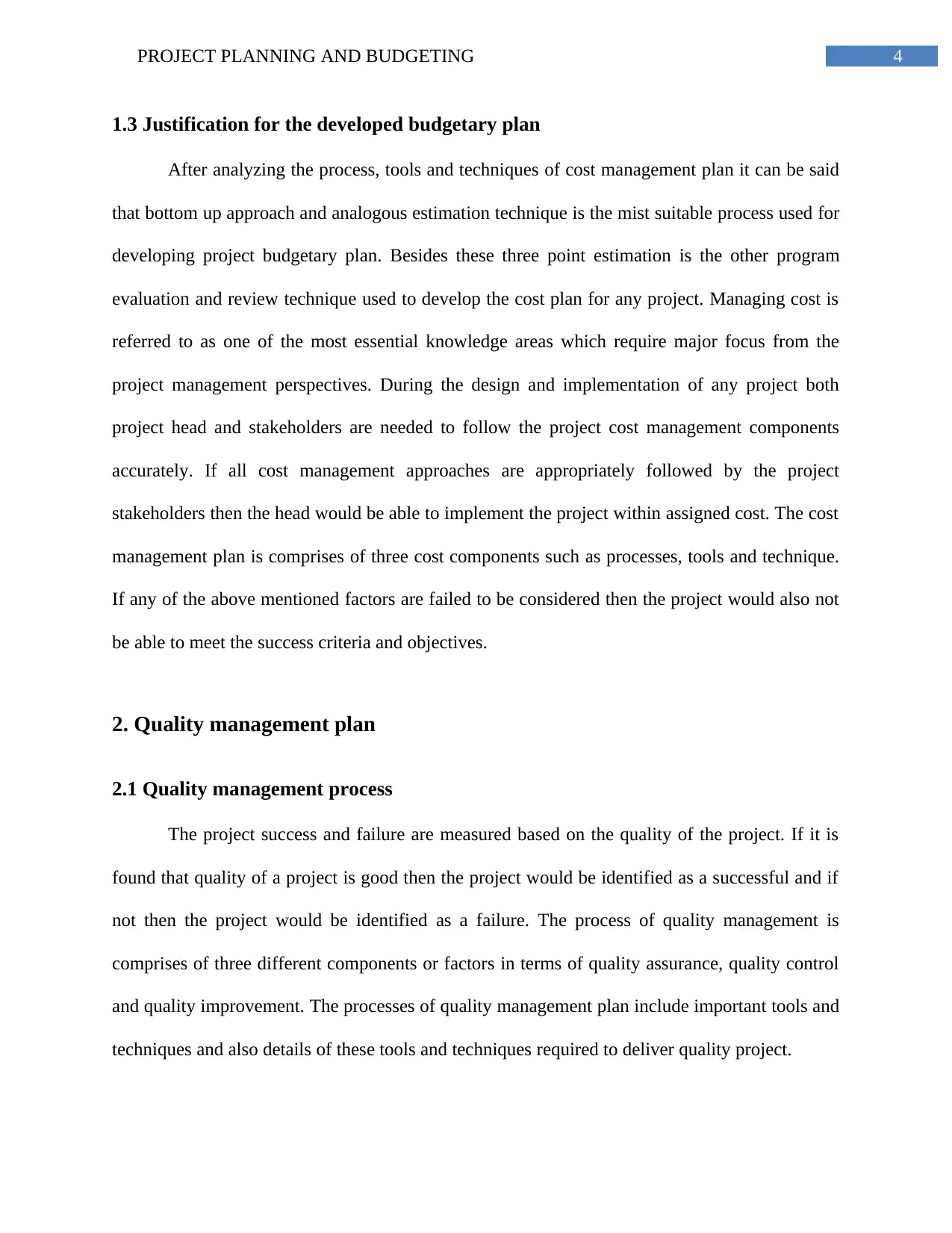
4PROJECT PLANNING AND BUDGETING
1.3 Justification for the developed budgetary plan
After analyzing the process, tools and techniques of cost management plan it can be said
that bottom up approach and analogous estimation technique is the mist suitable process used for
developing project budgetary plan. Besides these three point estimation is the other program
evaluation and review technique used to develop the cost plan for any project. Managing cost is
referred to as one of the most essential knowledge areas which require major focus from the
project management perspectives. During the design and implementation of any project both
project head and stakeholders are needed to follow the project cost management components
accurately. If all cost management approaches are appropriately followed by the project
stakeholders then the head would be able to implement the project within assigned cost. The cost
management plan is comprises of three cost components such as processes, tools and technique.
If any of the above mentioned factors are failed to be considered then the project would also not
be able to meet the success criteria and objectives.
2. Quality management plan
2.1 Quality management process
The project success and failure are measured based on the quality of the project. If it is
found that quality of a project is good then the project would be identified as a successful and if
not then the project would be identified as a failure. The process of quality management is
comprises of three different components or factors in terms of quality assurance, quality control
and quality improvement. The processes of quality management plan include important tools and
techniques and also details of these tools and techniques required to deliver quality project.
1.3 Justification for the developed budgetary plan
After analyzing the process, tools and techniques of cost management plan it can be said
that bottom up approach and analogous estimation technique is the mist suitable process used for
developing project budgetary plan. Besides these three point estimation is the other program
evaluation and review technique used to develop the cost plan for any project. Managing cost is
referred to as one of the most essential knowledge areas which require major focus from the
project management perspectives. During the design and implementation of any project both
project head and stakeholders are needed to follow the project cost management components
accurately. If all cost management approaches are appropriately followed by the project
stakeholders then the head would be able to implement the project within assigned cost. The cost
management plan is comprises of three cost components such as processes, tools and technique.
If any of the above mentioned factors are failed to be considered then the project would also not
be able to meet the success criteria and objectives.
2. Quality management plan
2.1 Quality management process
The project success and failure are measured based on the quality of the project. If it is
found that quality of a project is good then the project would be identified as a successful and if
not then the project would be identified as a failure. The process of quality management is
comprises of three different components or factors in terms of quality assurance, quality control
and quality improvement. The processes of quality management plan include important tools and
techniques and also details of these tools and techniques required to deliver quality project.
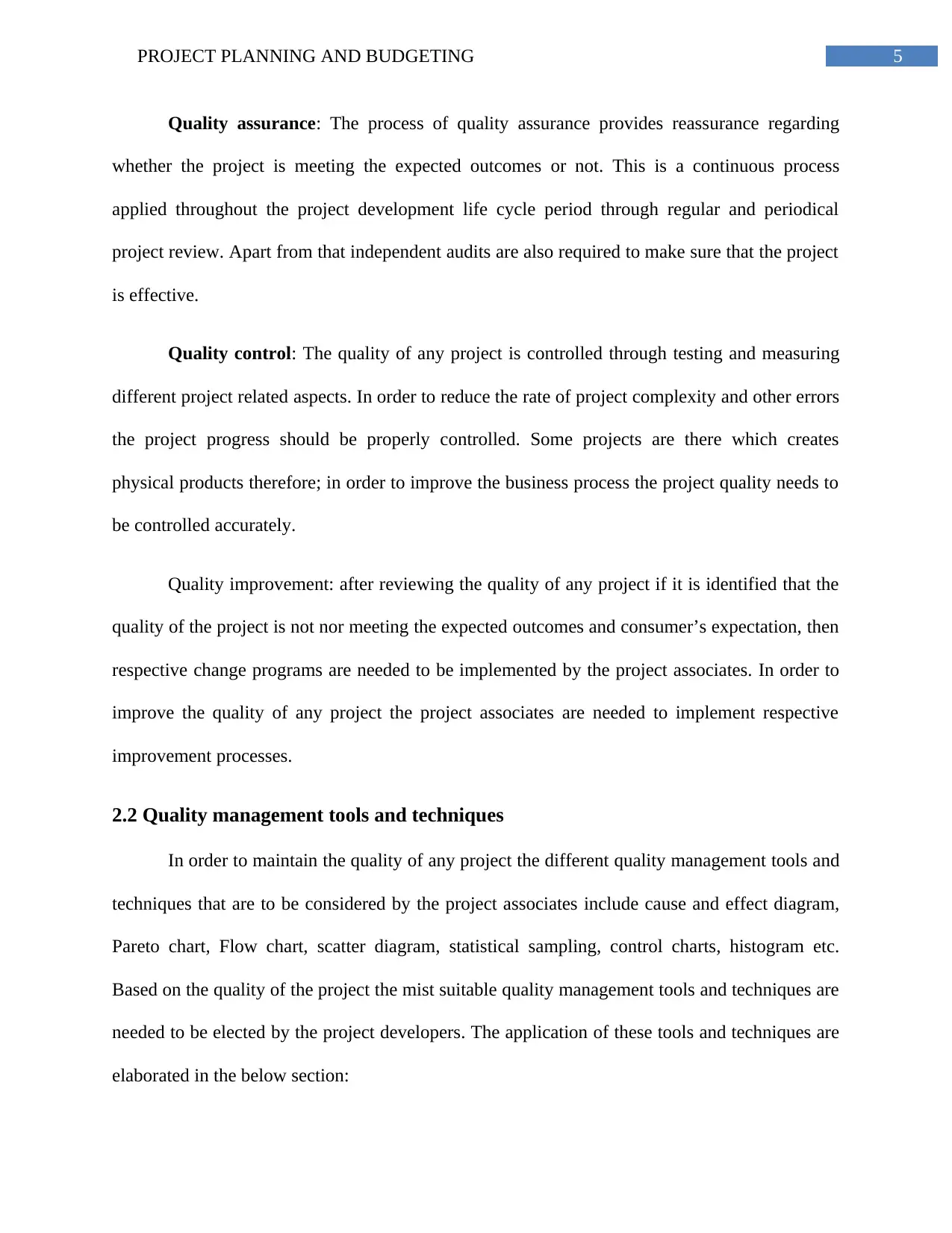
5PROJECT PLANNING AND BUDGETING
Quality assurance: The process of quality assurance provides reassurance regarding
whether the project is meeting the expected outcomes or not. This is a continuous process
applied throughout the project development life cycle period through regular and periodical
project review. Apart from that independent audits are also required to make sure that the project
is effective.
Quality control: The quality of any project is controlled through testing and measuring
different project related aspects. In order to reduce the rate of project complexity and other errors
the project progress should be properly controlled. Some projects are there which creates
physical products therefore; in order to improve the business process the project quality needs to
be controlled accurately.
Quality improvement: after reviewing the quality of any project if it is identified that the
quality of the project is not nor meeting the expected outcomes and consumer’s expectation, then
respective change programs are needed to be implemented by the project associates. In order to
improve the quality of any project the project associates are needed to implement respective
improvement processes.
2.2 Quality management tools and techniques
In order to maintain the quality of any project the different quality management tools and
techniques that are to be considered by the project associates include cause and effect diagram,
Pareto chart, Flow chart, scatter diagram, statistical sampling, control charts, histogram etc.
Based on the quality of the project the mist suitable quality management tools and techniques are
needed to be elected by the project developers. The application of these tools and techniques are
elaborated in the below section:
Quality assurance: The process of quality assurance provides reassurance regarding
whether the project is meeting the expected outcomes or not. This is a continuous process
applied throughout the project development life cycle period through regular and periodical
project review. Apart from that independent audits are also required to make sure that the project
is effective.
Quality control: The quality of any project is controlled through testing and measuring
different project related aspects. In order to reduce the rate of project complexity and other errors
the project progress should be properly controlled. Some projects are there which creates
physical products therefore; in order to improve the business process the project quality needs to
be controlled accurately.
Quality improvement: after reviewing the quality of any project if it is identified that the
quality of the project is not nor meeting the expected outcomes and consumer’s expectation, then
respective change programs are needed to be implemented by the project associates. In order to
improve the quality of any project the project associates are needed to implement respective
improvement processes.
2.2 Quality management tools and techniques
In order to maintain the quality of any project the different quality management tools and
techniques that are to be considered by the project associates include cause and effect diagram,
Pareto chart, Flow chart, scatter diagram, statistical sampling, control charts, histogram etc.
Based on the quality of the project the mist suitable quality management tools and techniques are
needed to be elected by the project developers. The application of these tools and techniques are
elaborated in the below section:
⊘ This is a preview!⊘
Do you want full access?
Subscribe today to unlock all pages.

Trusted by 1+ million students worldwide
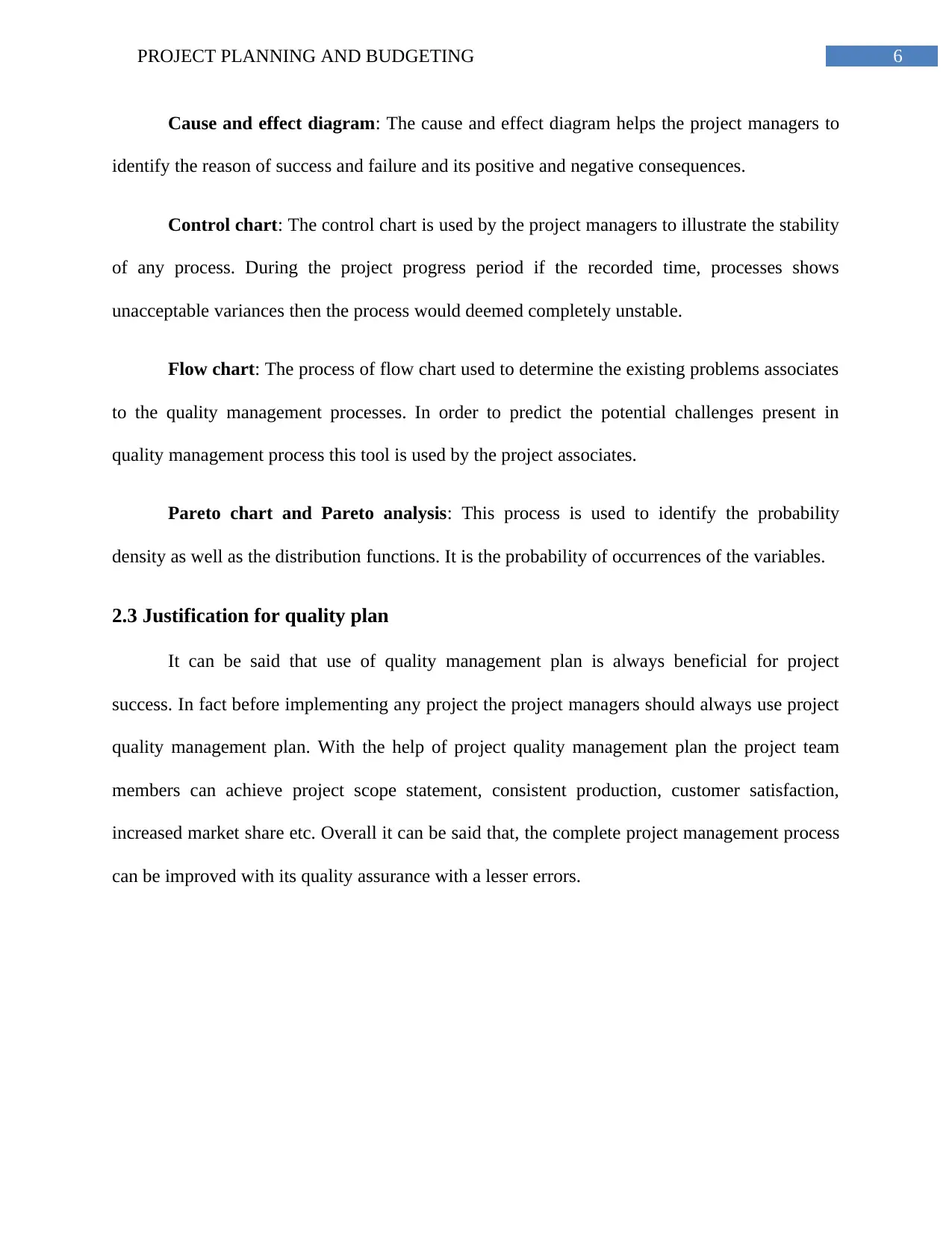
6PROJECT PLANNING AND BUDGETING
Cause and effect diagram: The cause and effect diagram helps the project managers to
identify the reason of success and failure and its positive and negative consequences.
Control chart: The control chart is used by the project managers to illustrate the stability
of any process. During the project progress period if the recorded time, processes shows
unacceptable variances then the process would deemed completely unstable.
Flow chart: The process of flow chart used to determine the existing problems associates
to the quality management processes. In order to predict the potential challenges present in
quality management process this tool is used by the project associates.
Pareto chart and Pareto analysis: This process is used to identify the probability
density as well as the distribution functions. It is the probability of occurrences of the variables.
2.3 Justification for quality plan
It can be said that use of quality management plan is always beneficial for project
success. In fact before implementing any project the project managers should always use project
quality management plan. With the help of project quality management plan the project team
members can achieve project scope statement, consistent production, customer satisfaction,
increased market share etc. Overall it can be said that, the complete project management process
can be improved with its quality assurance with a lesser errors.
Cause and effect diagram: The cause and effect diagram helps the project managers to
identify the reason of success and failure and its positive and negative consequences.
Control chart: The control chart is used by the project managers to illustrate the stability
of any process. During the project progress period if the recorded time, processes shows
unacceptable variances then the process would deemed completely unstable.
Flow chart: The process of flow chart used to determine the existing problems associates
to the quality management processes. In order to predict the potential challenges present in
quality management process this tool is used by the project associates.
Pareto chart and Pareto analysis: This process is used to identify the probability
density as well as the distribution functions. It is the probability of occurrences of the variables.
2.3 Justification for quality plan
It can be said that use of quality management plan is always beneficial for project
success. In fact before implementing any project the project managers should always use project
quality management plan. With the help of project quality management plan the project team
members can achieve project scope statement, consistent production, customer satisfaction,
increased market share etc. Overall it can be said that, the complete project management process
can be improved with its quality assurance with a lesser errors.
Paraphrase This Document
Need a fresh take? Get an instant paraphrase of this document with our AI Paraphraser
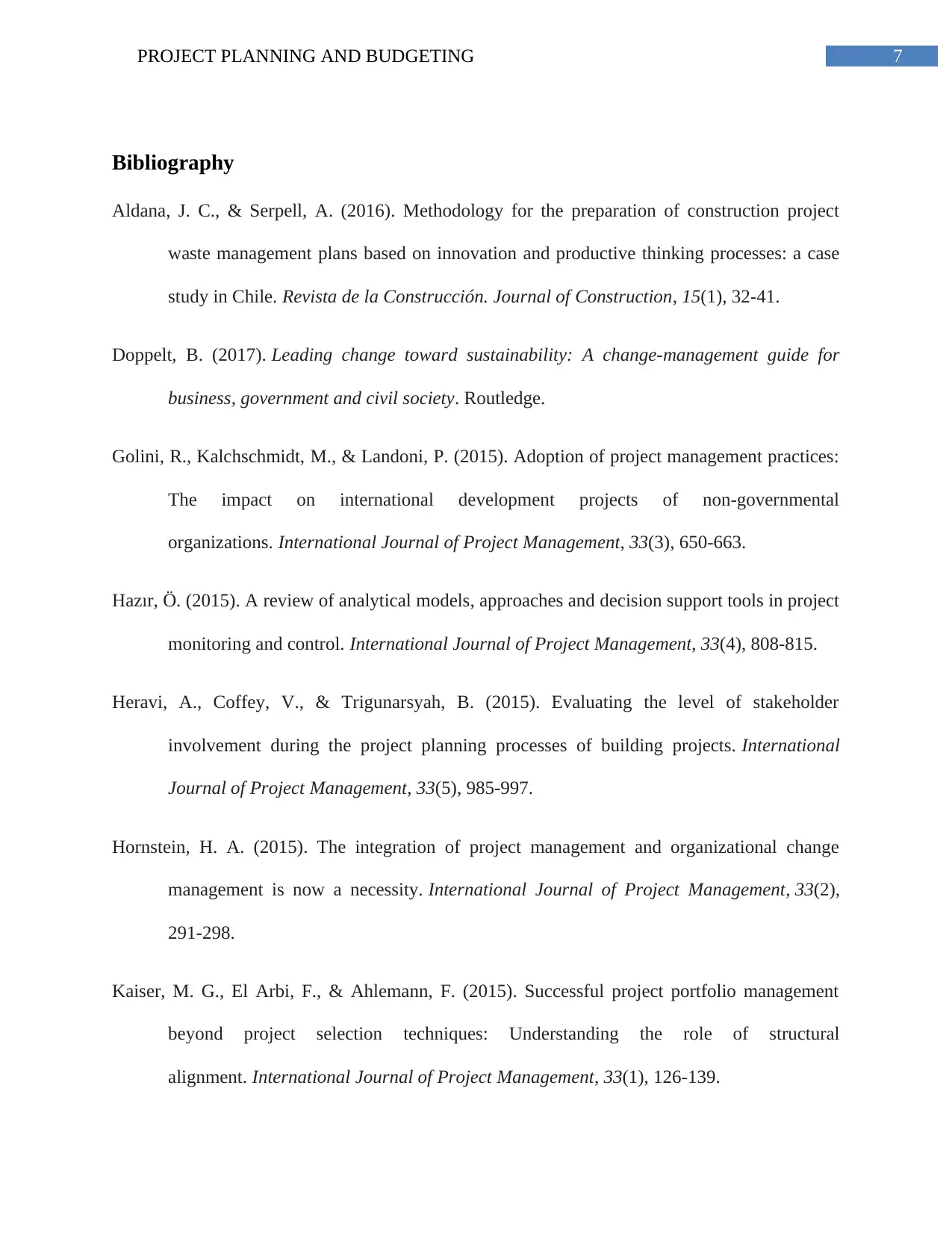
7PROJECT PLANNING AND BUDGETING
Bibliography
Aldana, J. C., & Serpell, A. (2016). Methodology for the preparation of construction project
waste management plans based on innovation and productive thinking processes: a case
study in Chile. Revista de la Construcción. Journal of Construction, 15(1), 32-41.
Doppelt, B. (2017). Leading change toward sustainability: A change-management guide for
business, government and civil society. Routledge.
Golini, R., Kalchschmidt, M., & Landoni, P. (2015). Adoption of project management practices:
The impact on international development projects of non-governmental
organizations. International Journal of Project Management, 33(3), 650-663.
Hazır, Ö. (2015). A review of analytical models, approaches and decision support tools in project
monitoring and control. International Journal of Project Management, 33(4), 808-815.
Heravi, A., Coffey, V., & Trigunarsyah, B. (2015). Evaluating the level of stakeholder
involvement during the project planning processes of building projects. International
Journal of Project Management, 33(5), 985-997.
Hornstein, H. A. (2015). The integration of project management and organizational change
management is now a necessity. International Journal of Project Management, 33(2),
291-298.
Kaiser, M. G., El Arbi, F., & Ahlemann, F. (2015). Successful project portfolio management
beyond project selection techniques: Understanding the role of structural
alignment. International Journal of Project Management, 33(1), 126-139.
Bibliography
Aldana, J. C., & Serpell, A. (2016). Methodology for the preparation of construction project
waste management plans based on innovation and productive thinking processes: a case
study in Chile. Revista de la Construcción. Journal of Construction, 15(1), 32-41.
Doppelt, B. (2017). Leading change toward sustainability: A change-management guide for
business, government and civil society. Routledge.
Golini, R., Kalchschmidt, M., & Landoni, P. (2015). Adoption of project management practices:
The impact on international development projects of non-governmental
organizations. International Journal of Project Management, 33(3), 650-663.
Hazır, Ö. (2015). A review of analytical models, approaches and decision support tools in project
monitoring and control. International Journal of Project Management, 33(4), 808-815.
Heravi, A., Coffey, V., & Trigunarsyah, B. (2015). Evaluating the level of stakeholder
involvement during the project planning processes of building projects. International
Journal of Project Management, 33(5), 985-997.
Hornstein, H. A. (2015). The integration of project management and organizational change
management is now a necessity. International Journal of Project Management, 33(2),
291-298.
Kaiser, M. G., El Arbi, F., & Ahlemann, F. (2015). Successful project portfolio management
beyond project selection techniques: Understanding the role of structural
alignment. International Journal of Project Management, 33(1), 126-139.
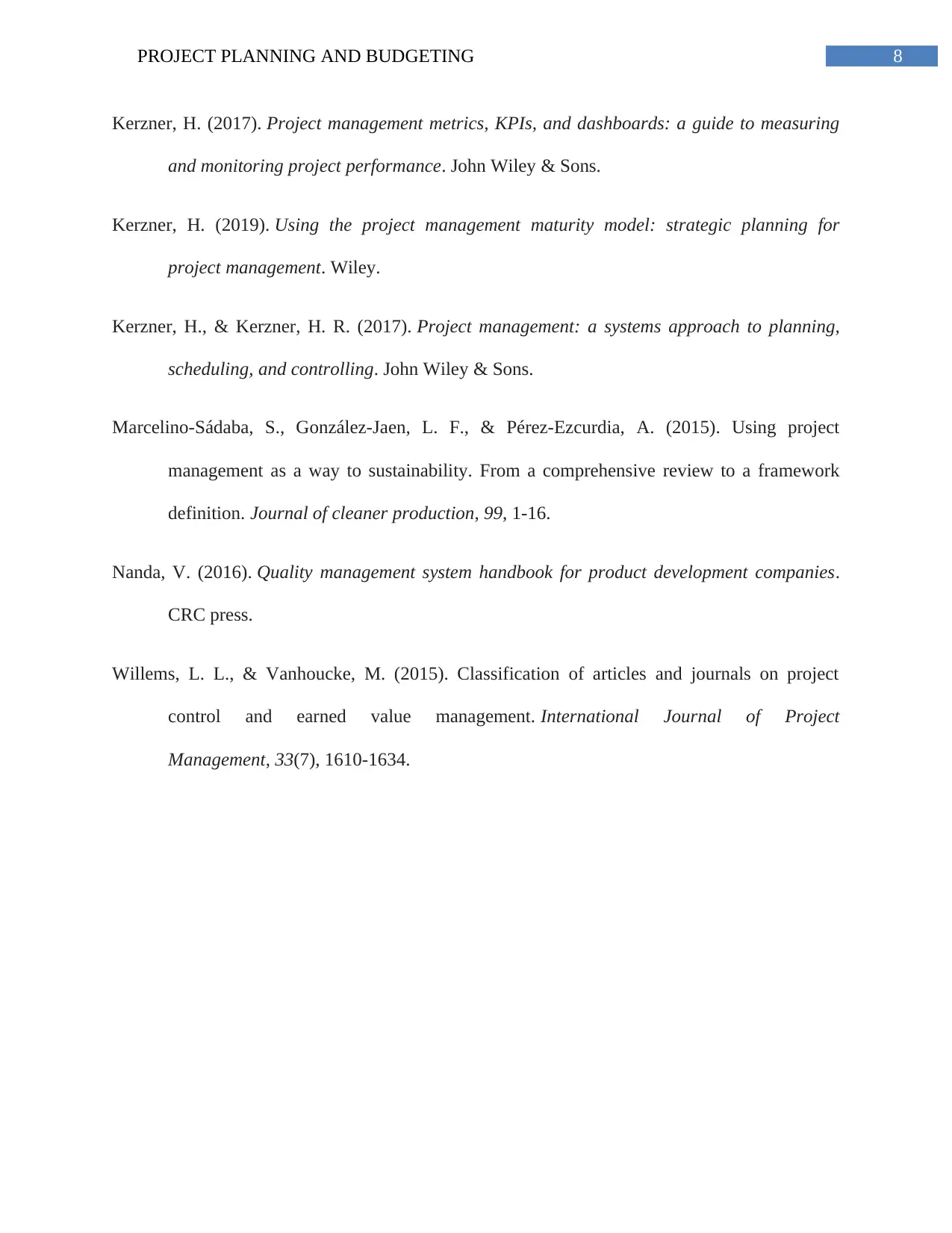
8PROJECT PLANNING AND BUDGETING
Kerzner, H. (2017). Project management metrics, KPIs, and dashboards: a guide to measuring
and monitoring project performance. John Wiley & Sons.
Kerzner, H. (2019). Using the project management maturity model: strategic planning for
project management. Wiley.
Kerzner, H., & Kerzner, H. R. (2017). Project management: a systems approach to planning,
scheduling, and controlling. John Wiley & Sons.
Marcelino-Sádaba, S., González-Jaen, L. F., & Pérez-Ezcurdia, A. (2015). Using project
management as a way to sustainability. From a comprehensive review to a framework
definition. Journal of cleaner production, 99, 1-16.
Nanda, V. (2016). Quality management system handbook for product development companies.
CRC press.
Willems, L. L., & Vanhoucke, M. (2015). Classification of articles and journals on project
control and earned value management. International Journal of Project
Management, 33(7), 1610-1634.
Kerzner, H. (2017). Project management metrics, KPIs, and dashboards: a guide to measuring
and monitoring project performance. John Wiley & Sons.
Kerzner, H. (2019). Using the project management maturity model: strategic planning for
project management. Wiley.
Kerzner, H., & Kerzner, H. R. (2017). Project management: a systems approach to planning,
scheduling, and controlling. John Wiley & Sons.
Marcelino-Sádaba, S., González-Jaen, L. F., & Pérez-Ezcurdia, A. (2015). Using project
management as a way to sustainability. From a comprehensive review to a framework
definition. Journal of cleaner production, 99, 1-16.
Nanda, V. (2016). Quality management system handbook for product development companies.
CRC press.
Willems, L. L., & Vanhoucke, M. (2015). Classification of articles and journals on project
control and earned value management. International Journal of Project
Management, 33(7), 1610-1634.
⊘ This is a preview!⊘
Do you want full access?
Subscribe today to unlock all pages.

Trusted by 1+ million students worldwide
1 out of 9
Related Documents
Your All-in-One AI-Powered Toolkit for Academic Success.
+13062052269
info@desklib.com
Available 24*7 on WhatsApp / Email
![[object Object]](/_next/static/media/star-bottom.7253800d.svg)
Unlock your academic potential
Copyright © 2020–2025 A2Z Services. All Rights Reserved. Developed and managed by ZUCOL.




